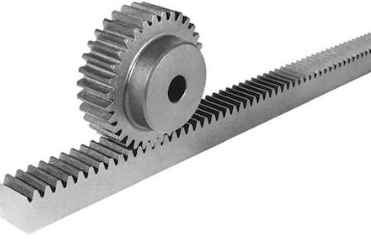Rack and Pinion Mechanism
Rack and pinion are a type of gear system that converts rotational motion into linear motion (or vice versa). It consists of two main components:
- Rack – A straight, toothed bar that provides linear movement.
- Pinion – A small, circular gear that engages with the rack to drive motion.
When the pinion rotates, it moves the rack in a straight line. Conversely, if the rack is forced to move, the pinion rotates.
Key Features of Rack and Pinion:
- Converts rotary motion into linear motion efficiently.
- Provides precise and direct movement.
- Simple, reliable, and widely used in mechanical systems.
- Available in straight racks (teeth cut straight) or helical racks (angled teeth for smoother operation).

Advantages:
✔ Simple and compact design
✔ High efficiency with minimal backlash
✔ Provides direct and precise motion control
✔ Can handle high loads, especially in industrial applications
Disadvantages:
✖ Limited stroke length (dependent on rack size)
✖ Requires proper lubrication to reduce wear and friction
✖ Can be noisy at high speeds, especially with straight-cut teeth
Common Applications:
- Steering Systems – Used in automobiles for precise directional control.
- CNC Machines – Converts motor rotation into linear tool movement.
- Lifts & Elevators – Used in vertical transport mechanisms.
- Railway Systems – Rack railways use this mechanism for steep inclines.
- Industrial Automation – Applied in conveyor systems and robotic arms.